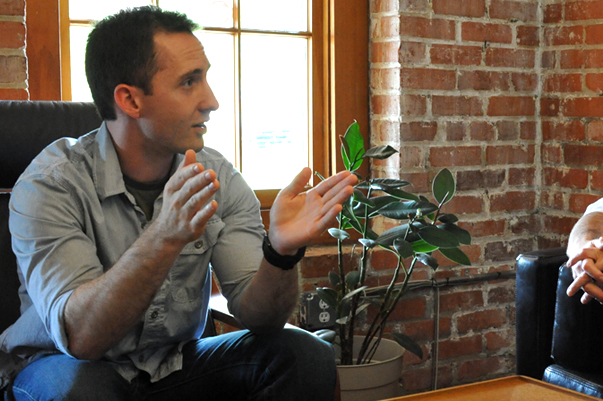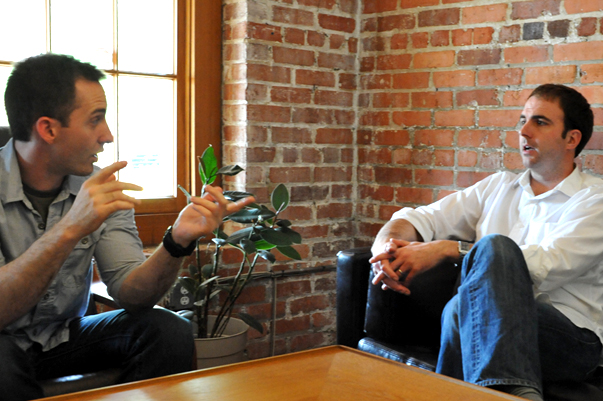This month, I’d like to present something a little different than our normal newsletter article. I’m excited to announce that our very own Mark O’Brien—Newfangled’s President—has published a book with RockBench Press that covers a detailed, nine-step strategic planning process specifically developed for agency website projects. Its title, A Website That Works: How Marketing Agencies Can Create Business Generating Websites, says it all: a website that works is a website that sells.
I recently sat down for an interview with Mark to dig into some of the topics he covers in his book. That interview, fully transcribed on the next page, ultimately presents a comprehensive vision for what today’s modern marketing website should be.
What You’ll Learn
- Why agency sites suffer from a lack of attention,
- The true role of creativity in an agency website (hint: it’s not just about inspiring the user),
- How agencies can create an effective and sustainable content strategy,
- and, How it all ties together to enable the agency website to attract, inform, and engage prospects.
Newfangled’s Mark O’Brien and Chris Butler discuss the vision for the modern marketing website that Mark has written about in his new book, A Website that Works: How Marketing Agencies Can Create Business Generating Websites.

Chris: What are some of the most common ways that you’ve observed agencies struggling with their own websites?
Mark: There are three main issues I’ve watched many marketing agencies struggle with on their own sites over the past decade. They are each pretty big topics, but let me try to sum up each one.
Number one, The Cobbler’s Children Syndrome: The first thing agency sites suffer from is a lack of attention. It’s very difficult for agencies to give themselves the marketing attention they give to their clients. When it comes to their websites, I think the main issue is a lack of direction; they aren’t sure what exactly to do with their site. This is a significant aspect of what motivated me to write this book. I wanted to give agencies a process they could use to set goals and create a road map for their own site development. I believe that if agencies have a plan for their website that they believe in and can get excited about, they’ll be much more likely to create a site that accomplishes the three main goals of a b2b marketing site. These goals are one, to bring in the right prospects through search engine optimized content that regularly documents the firm’s expertise; two, to intuitively guide those prospects to the areas of the site they are most interested in; and three, to bring the prospects into engagement with the agency through clear calls to action that are built around the site content. If the site is doing those three things, it will create business for the agency, and once it starts doing that there is no problem staying motivated to keep the site running at peak performance.
Number two, Misguided Creativity: It seems that many agency sites focus primarily on demonstrating the creativity of the firm. I believe that demonstrating creativity is essential, but demonstrating the thoughts and intelligence of the firm is equally important. The agency sites that generate the most business have a nice balance between content and creativity. These sites often have a very strong core page design, but not one that gets in the way of the prospect’s experience on the site. I suggest that agencies use the work in their portfolio to demonstrate their creativity, and allow the site to be a vehicle that allows prospects to easily navigate to the areas of the site they are most interested in, as opposed to having the site be a spectacle. The most successful agency websites let the work and thinking speak for themselves. The least successful agency sites, on the other hand, feel like a long and confusing design sales pitch.
And finally, Content Matters: The third most common struggle I notice agencies having with their own site is figuring out how to create thought leadership content on a regular basis. It is an understatement to say that most agency principals didn’t get in the marketing/design business because they wanted to write content. The painful reality, though, is that content is the currency of internet marketing, and every agency that wants to promote their business is now an internet marketer.
Creating content is difficult no matter who you are. In the book I spend quite a bit of time describing how agencies can create a content strategy that will impact their business without making impossible demands of their time and resources. Good content creation isn’t easy, but it is much easier to approach if you have clear goals in mind and a reliable plan for achieving those goals.

Chris: Early on in the book, you write, “Traffic is meaningless; action is everything.” We should put that line on t-shirts!

Mark: Ha! After the book…
Chris: Deal. But seriously, the line is compelling. That said, I bet that people who aren’t familiar with today’s best practices in lead generation might not know what you mean by “action.” How would you define action when it comes to a website’s audience?
Mark: Well, let’s first step back to the three goals of the agency website—to attract prospects, get them to the areas of the site they are most interested in, and then bring them into the next level of their relationship with the firm. That last part is the action I’m referring to in the sentence you quoted.
Having a prospect graduate to the next level of their relationship first means getting them to give the agency a little bit of their own information, say their name and email, in exchange for the convenience of receiving automatic updates when the agency publishes new thought leadership content.
Measuring the success of a website, an ad, or SEO, for example, on an increase in traffic is a very dangerous thing to do. For agencies, site traffic won’t pay any bills. It’s the quality of the traffic that matters, and the best way to measure quality is prospect engagement. Once a prospect volunteers their information and crosses that line of anonymity, the agency has the ability to consistently and subtly market to them under the guise of education. If the agency doesn’t get the prospect’s email, they have no ability to control or influence that prospect’s engagement with the site.
Chris: Blair Enns has said—and you mention this in the book—that “the purpose of the agency website is to inform and inspire.”
Mark: That’s one of my favorite quotes from Blair.
Chris: …but you leave “inspire” out of the roles in your website planning process. Let’s talk a bit about why.
Mark: OK. According to Blair, the agency website inspires with its portfolio and informs with its thought leadership content. I left “inspire” out of the 9-step planning process that I cover in the book because I don’t think agencies need much help with that. I created this process as a vehicle for agencies to get over the stumbling blocks they encounter when trying to create a site for their firm. Judging from the many agency sites I’ve seen over the years, they have no trouble with the inspire part of the equation. Conversely, I know they really struggle with the inform side of things, so I devoted quite a large portion of the book to helping agencies figure out how to make their sites very effective at attracting and engaging prospects through a thought-leadership based content strategy. It of course wasn’t my intention to undermine the inspirational role of the agency website, I just don’t think agencies need to read a book on how to do it.
Chris: I also like the analogy you draw between going for a walk in the woods and navigating a website.
Mark: Thanks! I had originally come up with that analogy for a blog post a few years ago, I then tried it out in a webinar and a few talks. It seemed to resonate, so I thought it would make sense to use it in the book.
Chris: So, let’s dig into that one, too. How, exactly, should using a website be like a walk in the woods?
Mark: This one gets to the second of the three roles of the agency website—to inform. A key aspect of the agency site being effective at delivering information is to make it easy for prospects who find the site to navigate it. I refer to sites that do a good job at this as being “intuitively navigable.” Sites don’t get to be this way by accident, though; there’s a real science behind it.
The way agencies usually make mistakes here is by starting their web projects with visual design. In a successful web project, there are actually two design stages—information design and visual design, and they really ought to go in that order. The best way to make a site that is intuitively navigable is to create a grayscale website that represents the site’s information design, specifically, the site’s pages, the navigation systems which connect those pages, and the functional elements that will be on each page. Agencies run into a lot of significant headaches when they try to work out this level of detail using traditional non-web-based site maps and wireframes, or if they try to figure this out after the site’s visual design has already been established.

Chris: Starting with design also diminishes the importance of a website’s content to its overall success. Actually, your definition of content strategy could probably form the outline for an entire book of its own—so this may be tough—but can you explain what content strategy is and how agencies should approach it?

Mark: I define a web content strategy as “a plan for regularly adding unique, expert, and indexable content to your site on a regular basis.” In the book, I spend about fifteen pages getting into the details of that definition. The basic idea is that a content strategy is a plan for an agency to demonstrate their expertise through their on-site writings. Most agencies choose blogs or newsletters to accomplish this. I view the site content as the heart of the agency marketing website, because the content is what makes the “attract” and “engage” roles possible.
Without lots of great, well-positioned, expertise-based content, the agency site wouldn’t have much of a chance to do well with search engines. The agency would probably show up on a Google search results page if a prospect searched for the agency’s name or key personnel. They don’t need to have a content strategy in place for that. But, the marketing website is about exploiting the opportunity that rests in the prospect base that desires the agency’s expertise, but doesn’t know about the agency. When the site attracts those people, it is working for the agency in a very unique and valuable way. The only way to have a site that works in this way is to employ a content strategy that fits the definition I gave. That is how a content strategy makes the “attract” role work.
The content is also what makes the “engage” role viable. Once prospects do find the site, the content then begins to educate them. The idea is to have the prospects identify the site as an educational resource. Once that association happens, the prospect will be eager to stay on top of the content, and a call to action inviting them to trade their name and email for automatic updates about the agency’s content is welcome. Without well-written educational content, the chances of a prospect either finding the agency site or finding themselves eager to give the agency their personal info are quite low.
Chris: A good content strategy sets a pretty high bar to reach for. What sites do you think make good examples for agencies just getting started to look at for inspiration?

Mark: The first step in having a site full of great content is having something unique to say, and that will only happen if the agency is uniquely positioned in the marketplace. If the agency is a true specialist, then they are going to know significantly more about their area of focus than most other firms. Google knows, in detail, what content resides on what sites. If an agency is yet another full service agency specializing in branding (or storytelling), Google is going to recognize that they are saying the same thing as every other agency it is indexing. When it comes across an expert agency’s site, it is going to come to rely on that site as its go-to resource for that topic. When Google identifies an agency site as this type of resource, very good things start happening for that agency.
So, to answer your question, some of the best small agency sites out there in terms of content strategy belong to agencies that are very focused in the type of client they serve. Here are a couple of examples:
Callahan Creek is an agency out of Lawrence, KS that focuses on shopper marketing. They state their area of expertise clearly on every page of the site, and they have a constantly growing wealth of written knowledge on their site that is focused on that topic. If a brand manager happened to search for something relating to the effect of staff endorsement on specialty retail brands, that person would probably find Callahan’s site. That searcher wouldn’t have been looking for Callahan, but they’d be happy to have found the educational resource their site is, and that is the start of a great prospect relationship.
Another is Design Force, an agency focusing on package design for consumer products. If a potential prospect of theirs happened to be searching about the impact of using licensed characters on packaging, they would find the Design Force site, and in it find a wealth of very deep knowledge about that specific aspect of package design.
These sites—and the businesses which own them—are not taking a shotgun approach. They know what they excel at, and choose to focus all of their energy on doing a specific type of work for a narrow industry segment. In doing so, they quickly become the best at that kind of work and are able to win projects across a much broader geographic range. Callahan Creek and Design Force are not the local neighborhood agencies, they are the world-renowned experts. They each use their websites to cast a geographically-wide net to catch a small number of prospects they are the perfect fit for. Once those prospects find their site, they feel as if the site (and the agency itself) were built just for them.
Chris: You make a great case for content strategy, but how do you know when it’s working?
Mark: Well, Chris, traffic is meaningless, action is everything…
Chris: Like I said, I’d wear that t-shirt!
Mark: So, it’s apparent that the agency site is working once the agency beings to notice that prospects are arriving at their site after they ask Google questions that relate not to the agency’s name, but to their expertise. Once the prospect arrives, agencies with successful sites will be able to see through their analytics that the prospects might have landed on a particular article, but then were able to easily navigate through the site, checking out all the other articles relating to the topic they initially asked Google about, until they finally convert on the site by filling out one of the agency’s call to action forms. Once the prospect converts, they are in the agencies lead-nurturing program which, again, is based on the content strategy. They will stay in that lead nurturing cycle until they have a need that they’d like to speak with the agency about, at which point the agency will get a call from a very well pre-qualified, informed, and pre-sold lead. When it comes to sales, there’s not much better than getting one of those calls.
The agency website will rarely close the deal, but it will certainly open a great many opportunities.
Chris: Excellent. This has been really informative, Mark. I think our readers are going to be very excited about the book! Thank you.

